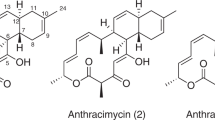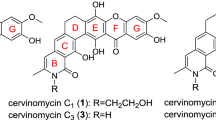Abstract
Seriniquinone was originally isolated as a melanoma-selective anti-cancer agent from a culture broth of marine bacteria. Pharmacological studies on its selectivity and unique target are ongoing. A new dihydronaphthothiophene (1) was synthesized by the biological transformation of seriniquinone using marine-derived actinomycete Streptomyces albogriseolus OM27-12, and its derivatives (2–4) were chemically synthesized. Compounds 1–4 exhibited selective cytotoxic activity against melanoma and improved solubility.
This is a preview of subscription content, access via your institution
Access options
Subscribe to this journal
Receive 12 print issues and online access
$259.00 per year
only $21.58 per issue
Buy this article
- Purchase on Springer Link
- Instant access to full article PDF
Prices may be subject to local taxes which are calculated during checkout





Similar content being viewed by others
References
Kang HK, Seo CH, Park Y. Marine peptides and their anti-infective activities. Mar Drugs. 2015;13:618–54.
Newman DJ, Cragg GM. Natural products as sources of new drugs over the nearly decades from 01/1981 to 09/2019. J Nat Prod. 2020;83:770–803.
Debbab A, Aly AH, Lin WH, Proksch P. Bioactive compounds from marine bacteria and fungi. Micro Biotechnol. 2010;3:544–63.
Hughes CC, Yang YL, Liu WT, Dorrestein PC, La Clair JJ, Fenical W. Marinopyrrole A target elucidation by acyl dye transfer. J Am Chem Soc. 2009;131:12094–96.
Jang KH, Nam SJ, Locke JB, Kauffman CA, Beatty DS, Paul LA, et al. Anthracimycin, a potent anthrax antibitotic from a marine-derived actinomycete. Angew Chem Int Ed Engl. 2013;52:7822–24.
Fukuda T, Shinkai M, Sasaki E, Nagai K, Kurihara Y, Kanamoto A, et al. Graphiumins, new thiodiketopiperazines from the marine-derived fungus Graphium sp. OPMF00224. J Antibiot. 2015;68:620–27.
Fukuda T, Takahashi M, Nagai K, Harunari E, Imada C, Tomoda H. Isomethoxyneihumicin, a new cytotoxic agent produced by marine Nocardiopsis alba KM6-1. J Antibiot. 2017;70:590–94.
Fukuda T, Nagai K, Kanamoto A, Tomoda H. 2-Epi-anthracimycin, a new cytotoxic agent from the marine-derived actinomycete Streptomyces sp. OPMA00631. J Antibiot. 2020;73:548–53.
Ohshiro T, Seki R, Fukuda T, Uchida R, Tomoda H. Celludinones, new inhibitors of sterol O-acyltransferase, produced by Talaromyces cellulolyticus BF-0307. J Antibiot. 2018;71:1000–7.
Trzoss L, Fukuda T, Costa-Lotufo LV, Jimenez P, La Clair JJ, Fenical W. Seriniquinone, a selective anticancer agent, induces cell death by autophagocytosis, targeting the cancer-protective protein dermcidin. Proc Natl Acad Sci USA. 2014;111:14687–92.
Moreira da Silva R, Carrão DB, Habenschus MD, Jimenez PC, Lopes NP, Fenical W, et al. Prediction of seriniquinone-drug interactions by in vitro inhibition of human cytochrome P450 enzymes. Toxicol Vitr. 2020;65:104820.
Hammons JC, Trzoss L, Jimenez PC, Hirata AS, Costa-Lotufo LV, La Clair JJ, et al. Advance of seriniquinone analogues as melanoma agents. ACS Med Chem Lett. 2019;10:186–90.
Guo Y, Zheng W, Rong X, Huang Y. A multilocus phylogeny of the Streptomyces griseus 16S rRNA gene clade: use of multilocus sequence analysis for streptomycete systematics. Int J Syst Evol Microbiol. 2008;58:149–59.
Berridge M, Tan A. Trans-plasma membrane electron transport: a cellular assay for NADH-and NADPH-oxidase based on extracellular, superoxide-mediated reduction of the sulfonated tetrazolium salt WST-1. Protoplasma 1998;205:74–82.
Fujii I, Ebizuka Y, Sankawa U. A novel anthraquinone ring cleavage enzyme from Aspergillus terreus. J Biochem. 1988;103:878–83.
Le Texier L, Roy S, Fosse C, Neuwels M, Azerad R. A biosynthetic microbial ability applied for the oxidative ring cleavage of non-natural heterocyclic quinones. Tetrahedron Lett. 2001;42:4135–37.
Funding
This work was supported by JSPS KAKENHI Grant Number 19K05855 (T.F.) and the Front and Grant for Scientific Research from the Faculty of Agriculture, Kindai University (T.F.).
Author information
Authors and Affiliations
Contributions
K.I., T.T., K.N., Y.F., T.T., M.A., Y.T., and T.F. designed research; K.I., T.T., K.N., Y.F., T.T., and T.F. performed research; K.I., T.T., K.N., Y.F., T.T., and T.F. contributed new reagents/analytic tools; K.I., T.T., K.N., Y.F., T.T., M.A., Y.T., and T.F. analyzed data; and K.I., T.T., K.N., Y.F., T.T., and T.F. wrote the paper.
Corresponding author
Ethics declarations
Conflict of interest
The authors declare no competing interests.
Additional information
Publisher’s note Springer Nature remains neutral with regard to jurisdictional claims in published maps and institutional affiliations.
Supplementary information
Rights and permissions
About this article
Cite this article
Ishida, K., Tanaka, T., Nagai, K. et al. New dihydronaphthothiophene derivatives by the biological transformation of seriniquinone using marine-derived actinomycete Streptomyces albogriseolus OM27-12. J Antibiot 75, 9–15 (2022). https://doi.org/10.1038/s41429-021-00484-5
Received:
Revised:
Accepted:
Published:
Issue Date:
DOI: https://doi.org/10.1038/s41429-021-00484-5
This article is cited by
-
Streptomyces pacificus sp. nov., a novel spongiicolazolicin-producing actinomycete isolated from a coastal sediment
The Journal of Antibiotics (2023)



